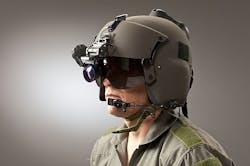Army helicopter avionics experts look to Elbit for displaying systems status on night-vision cockpit displays
Officials of the Defense Logistics Agency Land and Maritime division at Aberdeen Proving Ground, Md., awarded a maximum $12.3 million contract to Elbit for the Improved Signal Data Converter (ISDC) processor for U.S. Army helicopters.
Elbit's electro-optical ISDC is part of the Aviators Night Vision Imaging System Heads Up Display (ANVIS/HUD) has day and night displays to improve flight safety and situational awareness by reducing the pilot’s head and eye motion for cockpit scanning.
Related: http://www.avionics-intelligence.com/articles/2013/09/ai-apache-simulators.html
The system helps pilots make complicated maneuvers in bad weather and low visibility conditions, low altitudes, or night operations with enhanced survivability, Elbit officials say. The ANVIS/HUD night display is mounted on night vision goggles and the day display is mounted on the night vision goggles helmet mount.
More than 14 different U.S. military helicopter models covering 3,000 rotorcraft have the ESA ANVIS/HUD systems, Elbit officials say. The ISDC processor converts electronic signals from helicopter sensors to trend information for display either on the legacy ANVIS/HUD night optics or on the new lightweight flat panel night or day HUD optics.
The displayed information, which provides for reduced in-flight workloads and enhanced situational awareness is shown directly in front of the pilot's eyes during flight.
On this contract Elbit will do the work in Fort Worth, Texas, and should be finished by April 2016. For more information contact Elbit Systems of America online at www.elbitsystems-us.com, or the Defense Logistics Agency Land and Maritime division at www.landandmaritime.dla.mil.
About the Author
John Keller
Editor-in-Chief
John Keller is the Editor-in-Chief, Military & Aerospace Electronics Magazine--provides extensive coverage and analysis of enabling electronics and optoelectronic technologies in military, space and commercial aviation applications. John has been a member of the Military & Aerospace Electronics staff since 1989 and chief editor since 1995.
